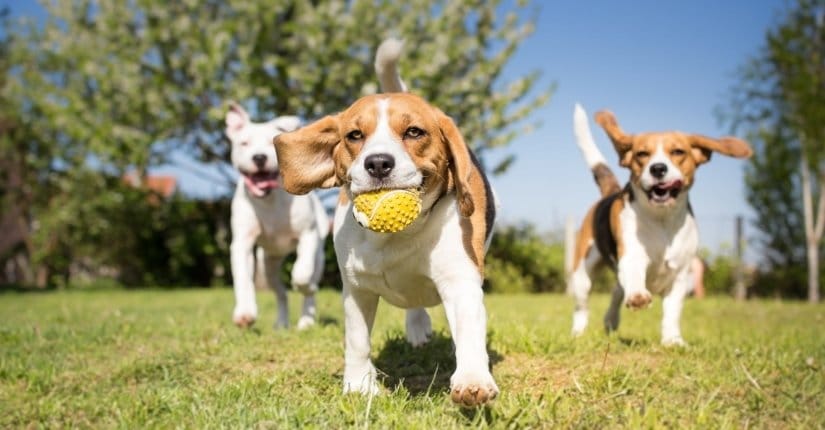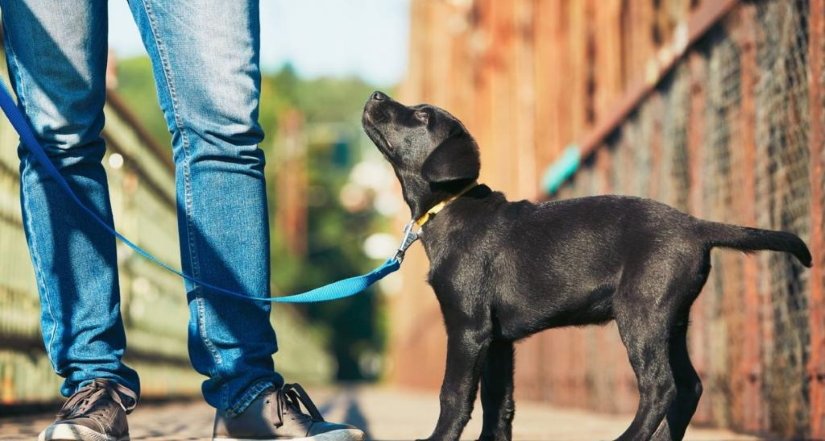An important key to basic and essential dog training tips and your puppy is to know enough about your dog as a breed. End your training session as soon as your puppy becomes bored or tired. Mini-sessions work well, yet sometimes super 3-5 minute sessions may be what’s needed to keep your puppy inspired.
Enforcing Basic Puppy Training Principles!
Positive reinforcement means having consistency in training. Practice each day for a few minutes with the end in mind; prevention of unwanted puppy behaviors. They are all important training principles to follow throughout puppyhood and during your dog’s adult life. Positive reinforcement is recommended whenever your puppy does something correctly by rewarding your puppy with his favorite high protein treats and praise.
There are three methods for teaching your puppy the basics of training.
- Capturing/shaping
- Lure/reward training
- Physical prompting
Verbal Corrections
Verbal corrections should always be used to encourage, yet should be given in a firm tone. “No” is an important word in puppy training, and should be used to prevent your puppy from doing something dangerous.
Give the command verbally when the undesired action is taking place, so that your puppy understands what is needed from him and when. Adding the word “No” to the undesired behavior makes it easily understood. You can be firm, but always in control.
Verbal corrections should always be given while the undesired puppy behavior is taking place. If you correct your puppy after he has done something incorrectly, it will not help him learn anything and you will only confuse him.
Housetraining Your Puppy The Easy Way
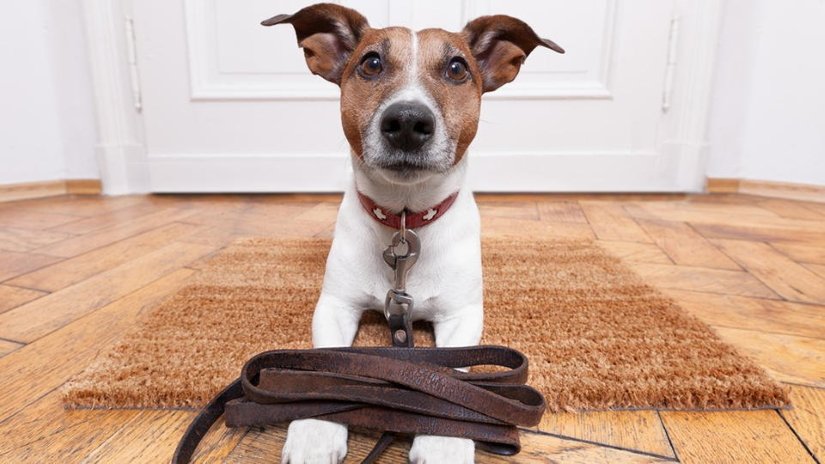
Accidents will always happen, so the key to successful potty training is to be in touch with your pup’s every move. Being vigilante during the first couple of weeks is important for successful house training. All puppies need to go potty after eating, drinking, waking and playing.
Bad habits during potty training can develop fast, yet can easily be avoided by simply reinforcing positive potty training. With house training, it’s necessary that you teach your puppy to go outside the home from the beginning.
You can also train your doggo to use puppy pads, and then re-train him to eliminate outside. Nonetheless, this takes time and since dogs develop preferences for certain areas in a short amount of time, it’s easier to proactively train him to go outside from the start.
Your puppy is unable to hold it for long periods of time. When he eats, drinks or has fun playing, he’ll need to go potty more often. You’ll need to give him more opportunities to eliminate outside, or inside if you’re using the puppy pads.
House Training Tips for Your Puppy
- Be consistent and proactive
- Always have puppy pads, newspapers or another absorbent material for your puppy to eliminate on in his litter box.
- Say “Go potty” every time your puppy needs to go.
- During the first couple of days, take your puppy to his potty area. You’ll need to show him where he needs to go.
- When leaving home for work or to run errands, confine your puppy to a room with the litter box and puppy pads.
- There are many different forms of house training. Choose the one that works best for both you and your puppy.
- Your puppy will need to go potty several times a day. If you’re not home, arrange that a neighbor or pet sitter spend some time with your puppy. They will need to follow the potty schedule consistently each day.
- Training your puppy takes time and patience.
How to Time Manage with Tools
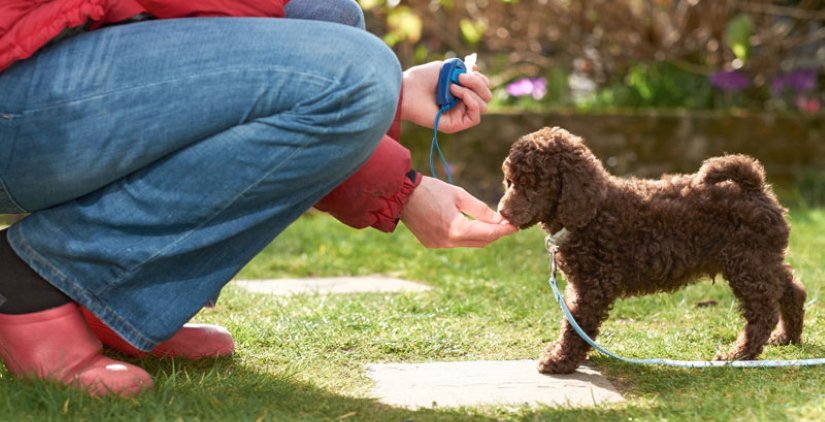
Housetraining a puppy means having the right training tools such as the stuffed Kong, or any dog chew toy, a comfortable crate of the right size, food and water bowls, food schedule, leash, collar and puppy training pads. These will all help in housetraining your new furry best friend, and will most times prevent him from having potty accidents.
With that said, there will be times when your puppy will have accidents, and these may not be his fault. Depending on your work schedule, home schedule, walk or outdoor puppy playtime schedule, there are various factors that come into play. Hiring a pet sitter or asking a neighbor to help you out, will help to reinforce housetraining, and allow for your puppy to feel confident in himself.
Gentle Supervision
Time management allows for you to supervise your puppy as you would a small child. You should try to spend as much time as possible with your puppy until he’s housetrained. Carry around a treat bag or bait bag with his favorite snacks like cubed hotdogs, cheese, cooked mini hamburger patties and keep rewarding him every time he goes to his designated spot for potty. Once he sees that bait bag full of treats, he’ll be so excited to get that reward.
Until your puppy is fully housetrained, it’s best to keep him supervised and on a leash if he’s not in his crate. Many pet parents feel more comfortable allocating a room close to the kitchen especially for their new puppy.
If you do this, you’ll need to do a tiny bit of puppy proofing by adding in a babyproof gate in the doorway, so that he’s never left alone and can watch and hear what’s going on around him. Puppies are sociable and need to be around their families. Do not lock your puppy up in the garage, or in a room away from everyone.
If you keep your puppy near you, you’ll soon have him housetrained because you’ll recognize the signs when he needs to go potty. House training means preventing your pup from developing bad habits. The fastest way of getting your puppy house trained is to try and avoid having him go potty indoors. When your pup is at home with you, keep him close by so that you’ll know when he needs to go outside. Take him outside as soon as he needs to go.
After the first few days, you’ll find it easier to figure out when he needs to go potty. Young puppies that are between the ages of 8-12 weeks will need to eliminate as often as every two hours. Nonetheless, if your puppy starts whining to go potty before that, take him out immediately. When your puppy grows older, he’ll need to go out less often.
If you’re crate training, remember to bring your puppy out of his crate, and to lead him outside. If you’re house training indoors and using puppy pads on a designated area, praise your puppy enthusiastically when he goes potty. Reward him with a healthy puppy treat, just like you would if you were outdoors.
Older geriatric dogs, small puppies, and even sickly dogs may find it easier to go potty inside, or in their potty area, rather than outside. Always check to see if your puppy or adult dog is physically capable of coping with excessive heat, snow or rain.
Puppy Crating Timeline Guidelines

These are puppy time guidelines for when your puppy needs to go potty.
- 8-10-week old puppy: potty breaks needed every 30-60 minutes
- 11-14-week old puppy: potty breaks needed every 1-3 hours
- 15-17-week old puppy: potty breaks needed every 3-4 hours
- 18 and more weeks: potty breaks will be needed every 4 hours, but no longer than 6 hours
Pet Sitter Help
Today, many of us spend much time out of the home. If you’ve recently brought home a puppy and are having a difficult time with potty training and scheduling potty training, one of the easiest things you can do is to hire a pet sitter. Most pet sitters are dog lovers that have experienced potty training with their own dogs.
- Interview a pet sitter that lives close by and organize a schedule that allows for your puppy to go potty according to his schedule. Keep in mind that this is just until he gets older. Housetraining becomes so much easier after the first few weeks.
- Ask your neighbor to help out for the first few weeks.
- Schedule your lunch breaks at work to allow for you to come home and check on your puppy.
- When your puppy gets older, visit some doggie daycare centers. These are a wonderful way for your puppy to socialize and make some friends while you’re at work.
The first step is teaching your puppy his name, and to come to you when you call out his name. No matter how long his registered name is, your puppy should have a short “home” name that is easily understandable to him and can be learned quickly. This is the name that he will respond to when you call him to your side.
Start by using this name from the very first day that he comes home, and use it with the same tone and in the same way every day. If you change names, you’ll only end up confusing him since he won’t understand who you’re calling.
-
Step One
- Use your puppy’s name correctly, and call him over to you when he’s awake and looking at you. You can also clap your hands gently to get his attention.
- Repeat this a few times over, making a huge fuss about what a great puppy he is, and rewarding him with his favorite tidbit when he responds.
- This will teach him to come to you when he hears you call out his name. He will understand that he’s being called, and when he does respond, he’ll be warmly greeted and rewarded with his favorite treat.
-
Step Two
- When your puppy has had a few days to get acquainted with you, you can now put on a light puppy collar, so that he can become used to having it on around his neck. In the beginning, your puppy may make a huge fuss, rolling around on the ground, struggling or trying to paw it off his neck.
- Have a tasty tidbit on hand so that you can get him to focus his attention on you and the treat, then play with him. In a short time, he will no longer want to remove the lightweight collar. Remove the collar after a few minutes.
-
Step Three
- The very next step in puppy training your puppy is to have him become used to the lightweight leash. Use a lightweight leash and attach it to your puppy’s collar.
- Carry your furry best friend outdoors where there will be a few things that will distract him. Let him investigate everything after placing him down. At this stage, he may not yet know that there is a leash dangling behind him, or he may make a huge fuss about it.
- If he does fuss, repeat the diversion and show him something of interest, perhaps a puppy toy. When he does eventually accept the leash, hold the end part of it and follow him around. Many puppies will start struggling against the leash, and attempt to slip out of the collar and leash. They may possibly also bite at it. Pat your puppy and reward him each time he accepts the leash. Try this for a few minutes each time.
-
Step Four
- When your cute puppy no longer fights the leash, try to direct him in the direction you wish for him to follow. Never pull on the leash, as this will frighten him, and he may start resenting his leash. As he grows into adolescence and becomes stronger and possibly more stubborn, there may very well be a battle of the wills, where both of you will be pulling in opposite directions.
- The most favorable method is a gentle pull in your direction. Maintain the encouragement. Rewarding him each time he gets started. Repeat the word “come” throughout the complete duration of puppy training. Once your puppy has mastered this step and starts walking easily on his leash, the next step is to show him how to follow you on your left side only.
-
Step Five
- With this new step you need to use the same method as you used previously when teaching your puppy how to respond correctly to you while on his leash. This time you use the word “heel”.
- This is not done in one day, or even a few days. Your new puppy will learn this over a period of a few weeks. All the while puppy training is done gradually with plenty of encouragement, praise and yummy treats. You need to make your puppy know that training is fun. The amount of time that it takes for this step to be completed will depend on your puppy, his personality and aptitude.
Puppy Training Pads or Outside?
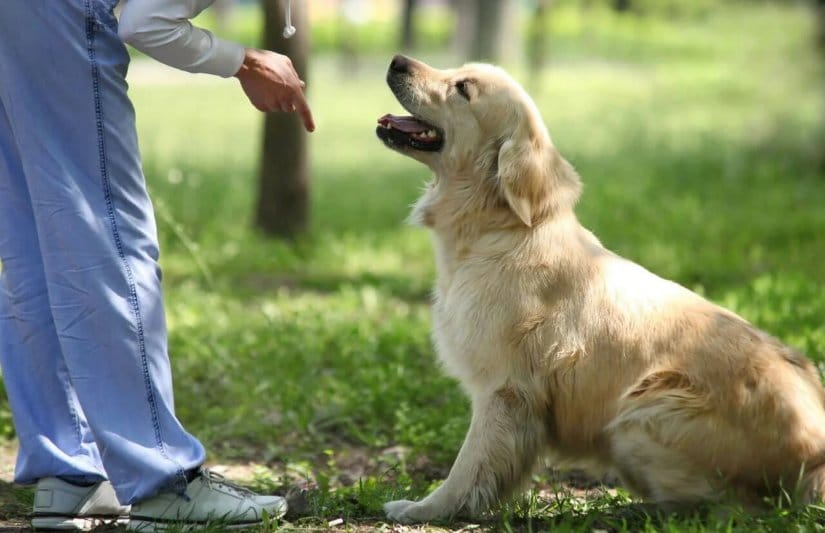
If your weather’s great and not too hot or cold, taking your puppy outside is not only refreshing and environmentally stimulating, it’s a great way for your puppy to sniff new scents and see other dogs. Yet, if you’re not at home as frequently as you’d like, puppy pads make it very convenient for everyone, especially if you live in the city. With that said, do your best to take your puppy outdoors for some sunshine and fresh air.
If you’re using puppy pads, you’ll need to cover your puppy’s floor so that he does not miss an area. Every week you can cover less space with the pads. If your puppy misses the pad, then start all over again and cover his complete floor. Most likely, the pads were removed too fast and he still needs to get the hang of things.
Housetraining can be time consuming, but needs to be kept consistent. Being gentle, encouraging and kind to your puppy is the very essence of being a good pet parent. Never yell or shout at your puppy. If you’re having problems with potty training, organize a scheduled appointment with a certified positive trainer and listen to what he has to say. Always set up your puppy for success, and never allow for bad habits to set in.
Indoor Potty Training to Outdoor Potty Training
It’s always good to have an indoor and outdoor potty area for your puppy. After your eight-week-old puppy has trained on puppy pads, you can then teach him to go outside. Housetraining can be made into a two-step process, with the first step being indoors with the use of puppy pads.
You can also teach him to potty train outside by alternating between going outside and inside. Bring some indoor grass sod inside to your puppy’s potty area, and place it inside a plastic litter box or on top of some puppy pads for extra protection.
All grass sod needs to be replaced at least three times a week. When your puppy is old enough to wait until he can go outside, there will be no need to keep the grass sod inside your home. Many pet parents enjoy having both the grass sod and the puppy training pads right next to each other, so that their puppy will have a choice.
- Praise your puppy each time he goes potty inside or outside.
- Think puppy potty time before your puppy needs to go so that there are fewer accidents in the beginning.
- Make sure to remove him from anyplace that is not his designated potty place when he needs to eliminate.
Outdoor Potty Tips
One of the easiest methods of puppy potty training is outdoor potty training. If you have a garden or outdoor patio, this process works much faster than using puppy pups simply because puppies prefer this method. Puppies will enjoy sniffing the bushes and exploring for a little while.
- Always use a leash if this takes place away from your home near a busy street or intersection.
- Keep it to 10 minutes for young puppies. If your puppy has not eliminated by then, go back inside and try a few minutes later. When he does eliminate reward him immediately with his favorite treat.
- Keep your puppy away from other dogs when going potty. This is to protect him from diseases until he has most of his vaccines, and also to allow him to focus on eliminating. If other dogs distract him, he may not go potty.
- If it’s snowing or freezing cold, use puppy pads instead.
- Predict when your furry best friend needs to go. After a few days, you’ll soon know when he needs to go.
Digging
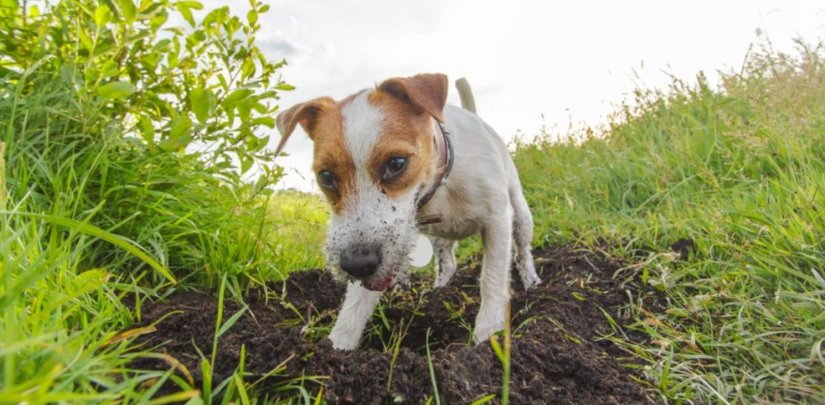
Don’t ever try to stop your puppy from digging. Instead give him his own spot in your garden to dig in. All puppies enjoy digging and will dig for many reasons. Nonetheless, there are many terrier breeds, which were bred especially to hunt rats in underground dens. This can result in major damage to your garden.
Solution
Digging relieves boredom and is a stress buster. Apart from having a cool spot to hang out in, many puppies will pursue digging to try and escape. It is simply not fair to keep your puppy inside to prevent digging from occurring. Digging, barking and escaping are usually problems resulting from untrained adolescent dogs, that are faced with a life that is boring, solitary confinement in their back yard and anxiety. Once a puppy is housetrained, he’ll soon stop digging and trying to escape from his yard.
- Choose a spot in your garden and bury some of your puppy’s favorite bones and toys.
- Play with him and encourage him to dig up the toys and bones.
- Your puppy will soon understand that this is his spot and the only spot to dig in.
- If he keeps going back to his old spot, use a playpen around your designated area and try again. After a few tries, you’ll be able to remove the playpen or fencing, and your puppy will automatically bury his toys in his “treasured safe spot. “
- Understand the way your puppy thinks and learn how to think like your puppy.
Chasing
Some dogs were bred only for hunting. These breeds are the most likely to enjoy chasing cars, other dogs, children and other smaller animals, including your cat. Chasing is a natural behavior and is an extension of your pup’s prey drive. It is a dangerous thrill for many puppies, which could lead to your pup getting hit by a car, or attacked by another dog.
Solution
- Teach your puppy to come when called.
- Keep your puppy on a leash until he understands and responds to the “come” command.
- Practice with your puppy during play sessions of chase, ending with the “come” command. Reward immediately and praise when your puppy comes to you.
- If your pup wants to chase bicycles or runners, get a friend to perform that activity close by your puppy. Keep your puppy calm and on a leash. Start this from 20 feet away and make sure that your puppy is focused on you. Reward immediately and gradually decrease the distance.
- Practice hand targeting, sit, down and stay with your puppy keeping him focused.
- As the distance is decreased, increase the frequency and the value of the treats given.
Retrieve
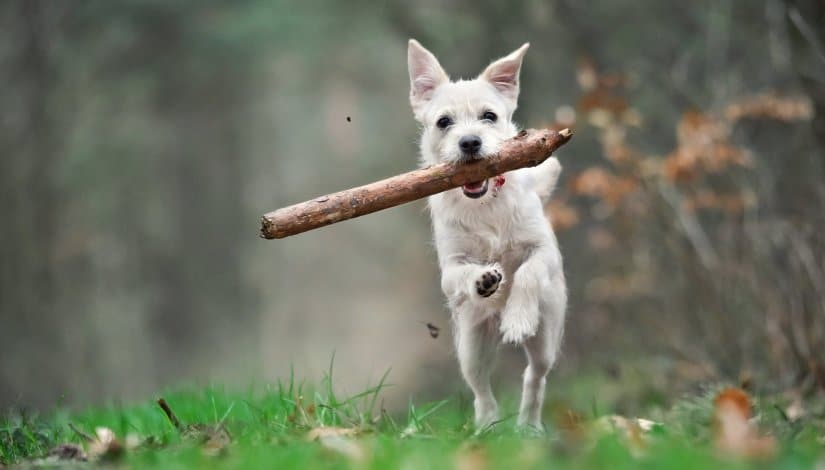
- This exercise is the basis of many fun activities and sports for your puppy.
- It teaches him how to get the toy or ball and bring it back to you.
- Retrieving helps him to get rid of excess energy while having fun at the same time
- Before throwing the ball, get your puppy excited. Move the ball erratically up and down so that he wants to get it.
- Next throw the ball a short distance away from you. As soon as he fetches the ball, encourage him to come back to you either by calling his name or slapping your thighs while crouching close to the ground.
- Give him lots of praise without taking the ball out of his mouth.
- Play and interacting with other dogs and puppies is a powerful reward for older puppies, most especially if they have been given puppy toys during puppyhood and enjoy playing with them.
- When your puppy knows how to retrieve, you can teach him to drop the ball right in front of you by encouraging him to fetch again and pointing at it with your finger. If he’s bored with this, try rolling it with your hand.
- When your puppy has the ball in his mouth, lower your hand directly under his mouth and get ready to catch the ball. You can do this while he’s running by having your hand stretched out and ready to catch the ball.
Loose Leash Walking
- When you’ve taught your furry best friend how to walk next to you, you’ll then need to teach him not to pull on his leash.
- Leashes should be kept loose most times to make walking your puppy more enjoyable.
- Stop walking the very minute he pulls at his leash.
- If your furry best friend is strong and pulls frantically, hold the leash towards your middle.
- Stop and wait. Do not let your puppy go any further. You need to teach him that when his leash goes tight and he pulls, the walking stops immediately.
- Bring him back to you and start walking again. Repeat every time he pulls. He’ll soon learn not to pull during his walks.
- Be consistent with training. When your puppy understands what you want and follows you calmly, relax the leash.
Training your furry best friend the basic and essential dog training tips is an important part of pet parenting, and should begin during puppyhood. Teaching your puppy how to behave in public, regardless of age, breed or temperament will not only help to raise well-behaved canine companions, but will also prevent the many dog bite attacks that seem to be increasing today.
Pet parents with poorly trained puppies, will end up with poorly trained adult dogs, and be a danger to those they come in contact with. These untrained dogs suffer as well, and most times end up at shelters.
